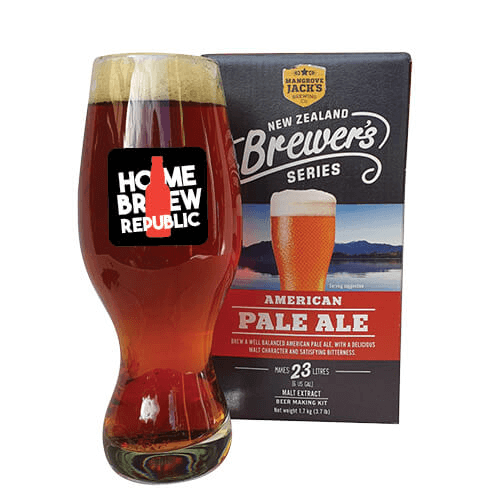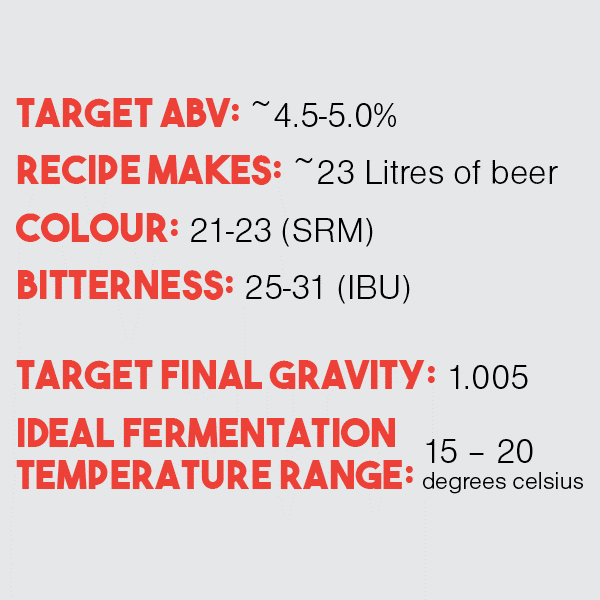
HBR Recipe#1 NZ American Pale Ale
NOTE TO READERS: Regretfully Mangrove Jack's have discontinued production of the New Zealand Brewers Series, which is the main kit for this recipe. We have left this content here for brewspiration.
Contrasting the typical APA style of beer the NZ American Pale Ale recipe will produce a lighter bodied finish with well-balanced malt characteristics.
The brew offers a confident but understated aroma with herbal notes and hints of pine and a confident citrus back-note.
The hop forward flavour follows the aroma and follows through with mid-strength malt characters and a moderate bitterness.
With a surprisingly light body the recipe offers a crisp, clean and refreshing brew making it exceptionally easy to drink.


What you need for fermentation
1 x Mangrove Jack’s New Zealand Brewers Series American Pale Ale
1 x Fermentis SafAle US-05 Yeast 11.5g
1 x Sachet Mangrove Jack’s Finings or Liquid Beer Finings
1.5 – 1.7kg of Light Liquid Malt Extract (unhopped).
Use Black Rock for a 1.7kg tin Mangrove Jacks for a 1.5kg pouch.
Suggested Hops
1 x (US) Columbus – Recipe recommends 30-40 grams
1 x (US) Cascade – Recipe recommends 10-15 grams
1 x Centennial – Recipe recommends 10-15 grams

Get Creative With Your Hops
Brewers can take a flexible approach to the hops you use, based on your own personal preference and product availiability.
The recipe uses 50-70 grams of hops in two stages of dry hopping.
Hops with a citrus profile or those suited to American style beers will work well with this recipe.
The Columbus Hop creates the herbal and earthy tones while the Centennial introduces the pine. The Cascade has a strong citrus profile.
The hops you choose can alter the flavour profile of your finished product.
Recipe Instructions
1. On brew day, clean and sanitise your fermenter, airlock, mixing paddle and any other item that will be used in the production of your beer.
2. Place the extract kit and liquid malt extract in a bowl of hot water for ten (10) minutes directly prior to mixing your wort.
3. Add three (3) litres of boiling water to your fermenter. Pour the contents of the Mangrove Jacks New Zealand Brewers Series American Pale Ale into the fermenter and squeeze out the remains.
4. Pour the contents of your Mangrove Jacks liquid malt extract pouch into the fermenter and squeeze out the remains.
5. Top the fermenter up to 23 litres with cold water.
6. Check the liquid temperature is below 25 degrees celsius ideally between 20-24 degrees celsius, then add the contents of the Fermentis SafAle US-05 Yeast. (Discard the yeast that is included with the Mangrove Jacks New Zealand Brewers Series American Pale Ale kit).
7. Once your yeast is pitched, we suggest you aim for a fermentation temperature range of 15-20 degrees celsius.
8. Ferment for four (4) days and then add 30-40 grams of US Columbus or your preferred hop pallets.
9. On day seven (7) or once specific gravity reaches is 1.020 add 10-15 grams each (20-30 grams in total) of US Cascade and Centennial, or your preferred hop pallets.
10. Fermentation will be complete once your specific gravity returns the same value for two consecutive days. Depending on your fermentation temperature range this could take until between days ten (10) and twelve (12). Final specific gravity is expected to be between 1.005 and 1.010. When fermentation is complete add Mangrove Jack’s Finings or Liquid Finings 24-48 hours before bottling your brew.
Bottle Maturing
We recommend that you allow the brew to mature in the bottles for six-eight (6-8) weeks before drinking to allow the flavours to mature.
As a minimum let the brew mature in bottles for four (4) weeks however if you start drinking the brew earlier, the hop flavours will not have fully settled. Drinking the brew from an earlier stage you can expect a stronger hop forward flavour initially.
Condition your brew in a cool and dry space. We recommend somewhere not in direct sunlight. Cool for 24-48 hours prior to drinking.
Things You Can Do To Improve Your Finished Product
Temperature Control
When fermentation temperature is too hot yeast can create adverse flavours in your beer. When fermentation temperature is too low fermentation can become lethargic affecting the fermentation process. To improve the flavour of your finished product and consistency of result use temperature control to maintain a target range.
Cold Crashing
Cold crashing is the process of chilling your brew to a temperature between 2-4 degrees Celsius normally for 1-2 days before you bottle. The process helps move sediment that may have been suspended in the brew to the bottom of the fermentation vessel supporting a cleaner and clearer finish.
Racking-Off
Racking-off is the process of transferring your brew from the primary fermenter into a secondary vessel for bottling. Applying this process before you bottle ensures that you separate the yeast cake from your brew and minimise the risk of residual material transferring to your final product in the bottling process.

